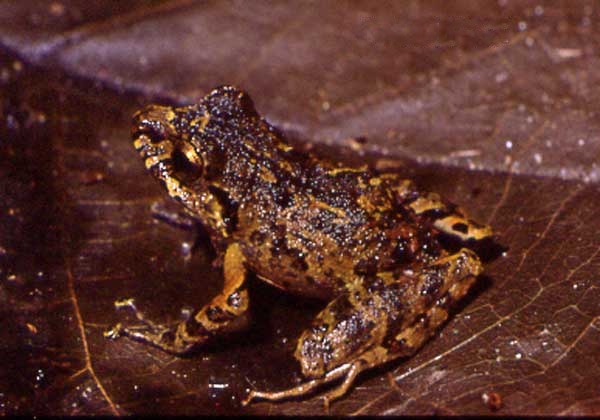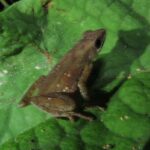- Introduction: The Quiet Charm of Ischnocnema manezinho
- Taxonomy and Classification: Understanding Family Roots
- Natural Habitat: Life among the Leaf Litter
- Physical Characteristics: A Lesson in Subtle Elegance
- Behavior and Life Cycle: Secrets of Survival
- Ecological Role: Guardians of Forest Balance
- Threats and Conservation Status: Facing an Uncertain Future
- Cultural and Scientific Significance: Silent Ambassadors for Conservation
- Conclusion: A Call to Awareness and Action
Introduction: The Quiet Charm of Ischnocnema manezinho#
Hidden beneath the emerald shadows of Brazil’s Atlantic rainforest, where moisture hangs thick in the air and sounds of wildlife knit together in a fragrant symphony, lives a tiny amphibian known chiefly to dedicated naturalists and local biodiversity researchers—the Ischnocnema manezinho. Quiet, unassuming, yet captivating, this little-known frog species represents a delicate link in its vibrant and fast-disappearing habitat. With careful observation, the intricate story of Ischnocnema manezinho unveils itself like the slow unrolling of a lush botanical scroll, revealing colors, behaviors, and ecological secrets fascinating enough to impress even the most seasoned biodiversity enthusiasts.
Formally classified under the genus Ischnocnema and part of the diverse Brachycephalidae family, I. manezinho embodies not only the subtle beauty of Brazilian wildlife but also the urgency surrounding habitat conservation in tropical ecosystems. While many frogs steal the spotlight with powerful vocalizations or exotic colors, this species captivates through understated grace, discreet calls, and adaptation to very specialized microhabitats. This article dives deeper into the enchanting universe of Ischnocnema manezinho, exploring its ecology, behaviors, significance, and conservation intricacies.
Taxonomy and Classification: Understanding Family Roots#
At first glance, taxonomy might seem purely academic, yet understanding a species’ scientific heritage illuminates the evolutionary journey this frog has undertaken. Belonging to the prolific family Brachycephalidae, the genus Ischnocnema comprises several small, direct-developing frog species known primarily for bypassing the tadpole stage during their life cycle.
Ischnocnema manezinho was formally described scientifically relatively recently, and the species’ description emerged as part of Brazil’s ongoing efforts to catalog its intensely rich amphibian diversity. With its closest relatives scattered across Brazil’s cloud forests and lower montane habitats, I. manezinho stands distinct through subtle morphological differences and a specialized ecological niche.
Natural Habitat: Life among the Leaf Litter#
Located predominantly within Brazil’s Santa Catarina Island and adjacent areas of southeastern Brazil, Ischnocnema manezinho thrives in the moist, shaded undergrowth of the Atlantic Rainforest. Picture an environment tangled with hues of vibrant greens, browns, and clandestine grays, where a carpet of fallen leaves and decaying logs provides refuge and sustenance. Amid such conditions, survival becomes an art of subtlety, and this frog has mastered the ability to remain nearly invisible in its habitat.
A World beneath our Feet#
Unlike many tree-dwelling frogs usually perched high above, I. manezinho claims the forest floor as its domain. This terrestrial lifestyle, dominated by shadows, moisture, and minimal sunlight, suits the species perfectly. With a perpetual dampness and layers of leaf litter nurturing an abundance of insect prey, it hosts precisely the conditions needed for these delicate amphibians to thrive in secretive comfort.
These frogs rarely stray far from their microhabitats. Each individual has a home range small enough to be measured in mere square meters—modest, yet sufficient, rich with resources. The leaf litter provides ample hunting opportunities, shelter from predators, and the perfect humid microclimate essential for amphibian skin hydration and gas exchange.
Physical Characteristics: A Lesson in Subtle Elegance#
Ischnocnema manezinho exemplifies understated beauty. Relatively small, adults measure between 15–23 millimeters in length—about the size of a human thumbnail—with delicate limbs perfectly suited for precise hopping and movement among textured forest debris.
Their coloration ranges from soft earthy tones like browns, grays, and subtle greens, frequently stippled with darker shades resembling the dappled shadows of leaves on the forest floor. This natural camouflage provides an invaluable adaptation to stay hidden from predators, blending seamlessly into their environment. Eyes, gem-like and alert, reveal a reflective sheen that occasionally betrays their presence, though such glimpses remain rare even for vigilant observers.
Behavior and Life Cycle: Secrets of Survival#
What fascinates researchers deeply about the species—and indeed the genus—is its unusual reproductive biology. Unlike classic amphibian lifecycle sequences featuring aquatic tadpole stages, I. manezinho undergoes direct development. This fascinating process bypasses free-swimming larvae altogether, with terrestrial eggs developing directly into miniature froglets. This adaptation allows survival without proximity to water bodies, essential for many amphibians but notably limiting in fragmented forest habitats.
A Symphony Often Unheard: The Frog’s Call#
In twilight hours, after rainfall injects fresh moisture into a humid forest evening, the males softly call from their hidden perches in the leaf litter. Their calls are subtle and discreet—delicate series of chirps and clicks, easy to overlook against the sonic tapestry of louder rainforest inhabitants. These subdued acoustic displays help secure mates without attracting nocturnal predators. The female chooses mates based on such quiet cues, thus continuing their lineage in cryptic fashion beneath the cover of darkness and shadow.
Resourceful Hunters of Ground-Level Prey#
With powerful yet precise leaps, these amphibians ambush small invertebrates scuttling discreetly through the leaf litter. Diet primarily consists of tiny arthropods such as ants, termites, mites, and springtails. Their perceptive eyes, specialized tongues, and speed of capture ensure efficient feeding despite the dimly lit habitat.
Ecological Role: Guardians of Forest Balance#
Within their rainforest home, Ischnocnema manezinho fulfills a small yet crucial ecological role. By feasting on abundant leaf-litter fauna, they contribute significantly to pest control and nutrient cycling processes. Conversely, they themselves provide nourishment for slightly larger forest predators, including spiders, birds, and small snakes, thereby reinforcing the intricate web of the forest ecosystem.
Being sensitive to environmental changes, this frog also serves as an invaluable bio-indicator, its presence signaling healthy, stable forest conditions and its absence immediately alerting conservationists to disruptions in ecosystem balance and integrity.
Threats and Conservation Status: Facing an Uncertain Future#
Unfortunately, despite the abundance and richness of life harbored by Brazil’s Atlantic Rainforest, modern development pressures pose severe risks to species like I. manezinho. Rapid urbanization leading to forest clearing, fragmentation, and habitat degradation threaten their limited habitats. Additionally, pollution, diseases like chytridiomycosis, and climate-related shifts only amplify these vulnerabilities.
The International Union for Conservation of Nature (IUCN) has not yet formally listed I. manezinho, given its recent discovery and limited data. Nevertheless, conservationists remain proactive in advocating habitat protection and further research to fully understand population trends and threats.
Cultural and Scientific Significance: Silent Ambassadors for Conservation#
On Santa Catarina Island, affectionately termed “manezinho” (little islander), residents have historically held deep connections with their landscapes. The naming of Ischnocnema manezinho symbolizes local pride, heritage, and acknowledgment of the frog’s uniqueness. Scientifically too, findings related to its distinctive direct-development lifecycle offer further understanding of amphibian evolution and adaptation mechanisms, thereby assisting broader conservation planning.
Conclusion: A Call to Awareness and Action#
In exploring the quiet yet meaningful existence of Ischnocnema manezinho, we witness a powerful testament to nature’s complexity, resilience, and interconnectedness. Preserving their habitats, understanding their biology, and celebrating even the smallest or most inconspicuous wildlife are integral steps toward responsible conservation and ecological awareness.
Let us remain mindful of these miniature forest residents, recognizing that each tiny amphibian species serves as a microcosm of biodiversity, whose precarious existence underscores our own responsibilities. By supporting conservation initiatives, respecting wildlife habitats, and engaging with nature-aware practices, we safeguard the delicate ecological balance on which we all depend.









